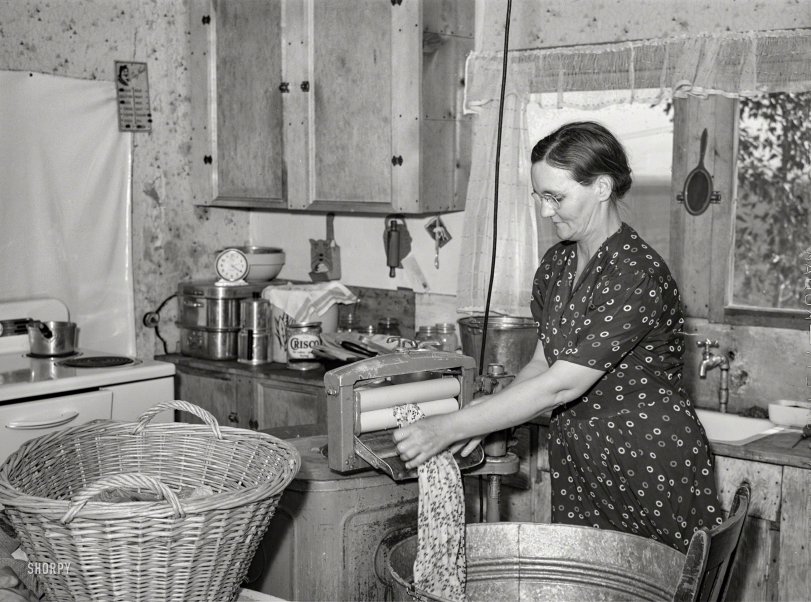


Framed or unframed, desk size to sofa size, printed by us in Arizona and Alabama since 2007. Explore now.
Shorpy is funded by you. Patreon contributors get an ad-free experience.
Learn more.

- Lofty addition
- In 1912
- Keenan Building
- Six years old
- Taken from the P.J. McArdle Roadway?
- It stood only 47 years
- Three track mind
- Incline to the right
- Reach for the sky, 1912 style
- No clean sweep
- Same Job Title, Same Face
- Sadly Lost
- Beautiful ...
- Where you get your kicks
- Aim High
- Pueblo Revival sisters
- Pueblo Neoclassicism
- Milk Man
- Regional dialect.
- Spielberg's inspiration
- Great Photo
- Loaf Story
- Do you still have the Rakes category?
- Could almost be a scene from the 1957 movie 'Hell Drivers'
- The Wages of Fear.
- Conspicuous by their absence
- Got Milk?
- All that aluminum
- No lefties
- Smoke 'em if you've got 'em
Print Emporium
The Busy Kitchen: 1941

May 1941. "Mrs. E.E. Botner, wife of FSA rehabilitation borrower, wringing laundry in electric wringer. This family has been on the project for about five years. Vale-Owyhee irrigation project, Malheur County, Oregon." Medium format negative by Russell Lee for the Farm Security Administration. View full size.
Kid memory
RGraham's photo brought back a long lost memory that made me smile. My mom had a mangle and I loved lying on the floor under it in the kitchen as the warm ironed sheets came off the roller on me as we listened to radio programs like "Life With Luigi" or Henry Aldrich.
Wringer Washer Primer
Several years ago a friend of mine in Vancouver, B.C., bought a Maytag wringer washer that had never been used in forty years since it was new. We fired it up, and I made a YouTube video of its first operation. For those unfamiliar with wringer washers, this should help out. I used machines like this decades ago. In Canada, wringer machines outsold automatics until 1968. In the U.S.A. this point was reached in 1951. One reason for this was that an automatic in Canada cost triple the price of a wringer washer. I have a 1944 Beatty wringer washer I still use from time to time.
Dangerous wringers
Back in the '50s my cousin got caught in one of those wringers. It chewed most of the skin off the bottom of his arm before my aunt could get it turned off. He had to wear a brace for several months to hold his arm out so the skin would heal properly. They were afraid his arm would be stuck to his side if they hadn't.
Power cord
I suppose that the electrical cord running straight up near her head is connected to the light socket, and powers the machine. They didn't have convenience outlets back then, in the older houses.
Mangler
Although I'm sure the wringer was more than capable of sucking in some body parts, the image below is what most people called a "mangler". It was a machine that ironed clothes and most any other items needing ironing. It took some practice to do it correctly.
[That's a mangle, not a "mangler." - Dave]
I guess they are both "mangles". https://en.wikipedia.org/wiki/Mangle_(machine) We still called it the mangler.
Here's a youtube instructional video if you're so inclined to try one out. https://www.youtube.com/watch?v=WkgN2YpeKu0

Wringers vs Mangles
The device on the washing machine for squeezing water out of wet laundry is a wringer. A "mangle" was a more common (and descriptive) name for an ironing machine that had two long heated rollers used for ironing flat items. Not many of these were sold because they took up a lot of space, were pricey, and--yes--because they easily mangled the hands of unwary users.
Watch that hair!
As Ozinor noted, a lot of accidents with those wringers. I can recall hearing stories of women who lost part of their scalps when their long hair got caught in the wringer.
Thet weren't called mangles for nothing
Lotta fingers (and occasionally other parts of the human anatomy) accidentally passed between those rollers.
The rest of the story ...
Out of curiosity, I looked up Census Bureau records based on her husband's name, and it is likely Mrs. E.E. (Lula) Botner was about 45 when this photo was taken. It appears she died in 1970 in Idaho. I expect she was probably plumb worn-out!
Life was tough for us ladies back then.
What's not to love
Electric stove and washing machine, running water -- all the modern conveniences in 1941. Reminds me of the Uriah Heep tune EZ Livin'.
























On Shorpy:
Today’s Top 5